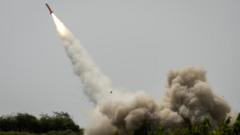In a rare exposé, the BBC reports on the US Space Force's activities at Buckley Space Force Base, where Guardians monitor global missile launches in real-time. Following recent missile threats, Colonel Ann Hughes highlights challenges from geopolitical tensions while emphasizing the rise of space as a contested battleground. As defense strategies evolve to include cyber and electromagnetic warfare, the Space Force prepares for emerging threats, particularly from adversaries like China and Russia.
Inside the US Space Force: Guardians Tracking Global Missile Threats

Inside the US Space Force: Guardians Tracking Global Missile Threats
First-hand access to Buckley Space Force Base reveals the operations behind the US's missile tracking and warning system, crucial for national defense.
At Buckley Space Force Base in Colorado, a command room hums with tension as Guardians, the personnel of the US Space Force, track potential missile threats from around the globe. In a historic first, international journalists have been granted access to this lair of missile warning and tracking operations. As the Guardians respond to drills with precision, they are prepared for real-world scenarios, as exemplified by recent missile launches from Iran.
Colonel Ann Hughes explained that despite the chaos of ongoing wars in the Middle East and Europe, the Guardians have proven their value in protecting US personnel, notably during a recent missile attack on an airbase in Qatar. She described the importance of their real-time tracking capabilities, which not only serve to safeguard US assets but also provide warnings to allied forces, including potentially aiding Ukraine against Russian aggression.
This innovative defense posture has resulted from strategic directives aiming at creating a robust missile defense shield, dubbed the Golden Dome. Plans for the protection initiative are ambitious, necessitating significant investment to match the rapid advancements in military technology, especially from rivals like China and Russia.
General David Miller, head of Space Operations, affirms a dual focus on developing capabilities and preparing for heightened conflict in space, given the growing presence and capabilities of adversaries. The assertion that space has become a warfighting domain encapsulates the era’s shift, as China’s military endeavors lead to an increasingly competitive and congested orbital environment filled with thousands of satellites.
Colonel Phoenix Hauser spoke about the challenges that come with such developments, describing near-collisions and unsafe encounters with adversarial satellites as an alarming occurrence. These developments hint at a future where prepared combat in space might mirror dogfights in the air, a reality that the Space Force is diligently preparing for amid growing competition.
The US Space Force's evolution over the past five years underscores its vital role in American military strategy. Recent operations, such as the B-2 bomber strikes targeting Iranian nuclear installations, showcase how space-based capabilities enhance the effectiveness of ground missions, ensuring operational success while maintaining crucial communication links despite adversarial interference.
With US interests heavily reliant on maintaining dominance in space, General Miller’s emphasis on strength as a deterrent resonates as the Space Force continues its mission of preserving national security while remaining vigilant against the pending threats posed by adversaries. The echo of "God help you!" serves as both a warning and a commitment to the rigorous defense of American interests in this new frontier.



















